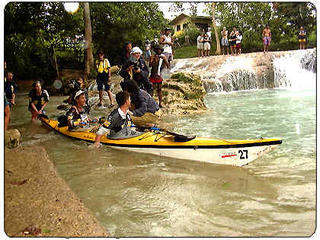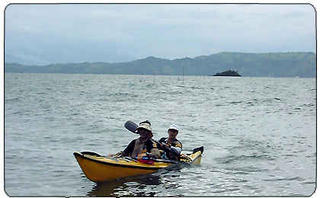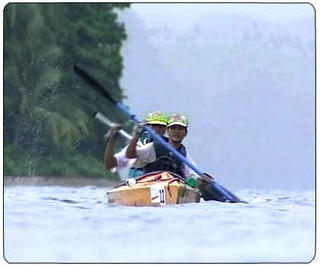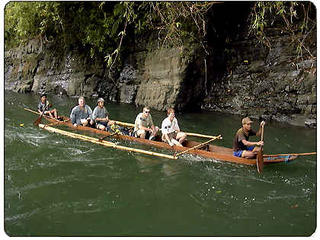THE WORLD'S NEWEST HARDEST RACE
SAMAR ISLAND GUIDE: EXPLORER JONI A. BONIFACIO TEL: 055-2512301
CELL:09192943865 / 09053233572
WEBSITE: www.bonifaciojoni.blogspot.com

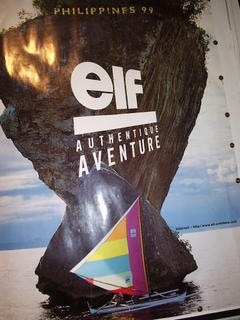





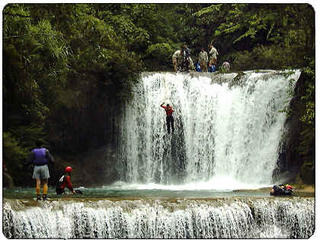




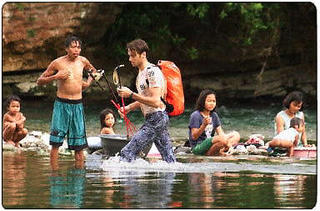
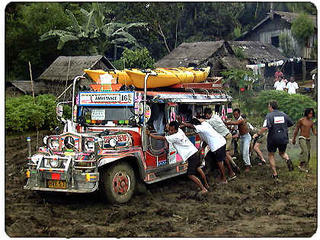




The World's Newest Hardest Race:The Elf Authentic Adventure
Just Before the Action
Friday, April 16, 1999Catarman, on the island of Samar, Philippines
There's still a day to go before the start of the Elf Authentic Adventure, but just getting to this dusty city on Samar's northern coast for Saturday's 12 PM start has been an endurance test. Fifteen to twenty hours of plane flights for most of the racers was followed by a harrowing 10-hour jeep ride along the 150-kilometer coastal road from the southern city of Tacloban. One jeep load of support staff took a wrong turn after leaving Tacloban at noon Thursday. Unaware that the main highway was washed out from a recent typhoon, they pulled into Catarman at 6 a.m. today. At an early morning briefing, race organizer Gerard Fusil made big scary promises. "We have put together the best course I have ever organized in my life. It will be very, very difficult."
The Elf course heads south, crossing the densely forested interior of Samar twice and taking racers along coastal routes on the western Samar Sea and the eastern Philippine sea. All told, the racers will kayak 225 kilometers, climb, hike and cave for 213 kilometers, canoe for 30 kilometers, rollerblade for 101 kilometers and sail 103 kilometers before reaching Tacloban. It's not even noon yet and temperatures are in the high 90's with 96% humidity. All the teams are spending the rest of the day poring over maps of the route, mindful of Fusil's ominous warning at the end of this morning's meeting: "Don't get lost. It will be very difficult for us to find you."
How Authentic?
by Gina Mission, Philippines
On April 17, 1999, the townspeople of Catarman woke up to a day that they would never forget. There, scattered on the seashore of Pambuhan Beach, decked out in exotic regalia, were 22 adventure racing teams from 14 countries around the world. They were surrounded by all the brouhaha of a major international sporting event: race marshals, event organizers, members of the press, sponsors' representatives and curious spectators. This was the start of the first-ever Elf Authentic Adventure race, the newest creation of Gerard Fusil, one of the founding fathers of the "sport" of adventure racing.
But the racers and their support network weren't the only ones there: adding to the general melee prior to the start was a group of Filipino demonstrators chanting slogans of protest and carrying signs that read: "Respect our rights! No to Elf!" and "Gerard Fusil: global capitalist pirate!"
The protesters in Samar weren't the only ones who raised their voices against the event; the Elf Authentic had been created from a situation of confusion and ill will, and right from the start had been greeted with considerable skepticism.
It was hardly an auspicious start to a race that organizers had declared would be different from other major international sporting events. Intended to bring racers closer to the local residents, it included community projects as part of the race format to leave behind something of lasting value for the common people. It seemed like Gerard Fusil's latest dream had gone badly wrong.
Fusil was undoubtedly smarting after being ousted from the original event that he had created, the highly successful Raid Gauloises. His reaction was to come up with a new event - but the international adventure racing circuit was already crowded. The cost and commitment of entering a big adventure race means most teams can do one event a year at most and over the years the Raid - and the original adventure race, the Southern Traverse - had been joined by the Eco Challenge, the Mild Seven Outdoor Quest, the Beast of the East and others. Fusil needed something original to draw attention, competitors and sponsors from these other events.
The Elf Authentic AdventureFusil himself has a certain mystique about him. His philosophical outlook and French flair combine to give him a character that works well as a marketing tool to promote his ideas. Capitalizing on his name, and partly on his split with the Raid, he introduced yet another concept, one that he promised to be definitive. One that would transform the sport from its present form.
In this new incarnation, athletes would more closely resemble explorers of old, by maintaining a level of self-sufficiency during the race and have a closer interaction with the land and its people. But they would go one step further than their predecessors - who often had a highly questionable impact on the land they passed through - the competitors would be required to give something tangible back to the people in the host country. Either a gift or some kind of social program.
This new concept was introduced to the extreme adventure racing world as the Elf Authentic Adventure.
While not directly critical of other races, Fusil said that generally, "athletes just go to a country to compete and nothing else. The participants just see stadiums, circuits and hotels. Competitors pass through an area with a hello to children and that's it." In an interview with Adventure Racing World before the 1999 event, he said: "The goal of this competition is to live incredible situations, and also meet people-from the same team, other teams and the host country."
The Elf, said Fusil, would be different. Elf participants would set up a project to give something back to the community - be it artistic, cultural, scientific, medical, environmental protection or awareness-before, during, and after the race.
In addition, organizers imposed total independence by leaving the teams to organize logistics to carry them through the race. For this, and other reasons, the race was expected to be more challenging than most adventure races, and a class system was devised to keep racers from dropping out. Teams were classified into three categories, Extreme class, Adventure class, and Discovery class, based on whether or not they made it out to Checkpoint 9 within 24 hours after the leading team had passed it.
But people outside the race were skeptical of the self-sufficiency aspect and the concept of the Elf being the "authentic" race. Critics wondered if Fusil was merely trying to re-package a standard adventure race to distinguish it from the others. Certainly, like all adventure races, the course of the Elf was kept secret - all that was announced was the country: the Philippines.
* * *Sometime in 1998, the residents of Catarman, northern Samar, noticed a group of foreigners and Filipinos arrive in their homeland. At the time, it didn't seem like anything for them to be alarmed about. But months later, Catarman folks started hearing some unpleasant things about the visit. The foreigners, they now heard, were searching for minerals while taking off with the indigenous flora and fauna.
That the foreigners remained stubbornly silent about the actual purpose of the visit didn't help. It was, of course, the Elf course planners charting the course, but if communication with the locals was one of the goals of the race, the event wasn't off to a good start. By the time everyone lined up in Samar on race day, protesters were there to greet them. And the critics were having a field day.
To his credit, Fusil remained undaunted by the criticism levelled against the Elf. He assured local protesters at the opening ceremony that the Elf would increase tourism activity in the region. The race, he said, would open the eyes of the world to the "magnificent secrets of Samar and Leyte." While undoubtedly an adventure haven, the beauty of the twin islands, located at the heart of the Philippines, was relatively unknown, even to some Filipinos.
Survival of the fittestAt last, around noontime on April 17, the gun sounded to signal the start of the race. To complete the 623-km course, racers would kayak, trek, spelunk, rent and sail outrigger canoes, hike, rollerblade and finally sail traditional vessels called Subirans, which the participants had to make themselves.
But Fusil's problems were far from over. On the eighth day, when the winning teams were expected to cross the finish line, Fusil found the members of the leading team, Spie, stuck in a muddy section of the course and unable to walk. Worse, they still had 250km left to race. They weren't the only ones, though. Other teams had been disqualified after having members drop out, had abandoned the race, or had been demoted to a lower category for not making it to the checkpoint at the designated time. What was worse, a jungle foot disease was slowly infecting most racers, disabling some.
Fusil was worried that few teams, if any, would finish the race by the awards ceremony day, April 29. Even the two leading teams were having great difficulty walking. So he made the critical decision to shorten the last jungle leg. The decision, however, sparked criticism from Sabah's Asia Ability team, which was in third place to that point. Putting their local knowledge to maximum advantage, they were going fast through the jungle and taking care to keep their feet clean and dry to avoid the disease that was affecting the other teams. They felt they could have easily passed the two leading teams on this vital leg. If the race was an "authentic" event, they questioned, shouldn't those ahead of them accept the price of trying to win at all costs?
Fusil disagreed with that.
"My goal has never been to exhaust the competitors. I see sometimes here and there competitions that I don't like at all, because it seems like the goal is to show on TV people with their faces totally destroyed, begging for some water-as though the goal is to avoid being killed. That is not my spirit at all. My spirit is that the competitors need a lot of qualities, to be very comfortable in nature, to be fit, to be very clever, and because they are like that, to discover new horizons, new worlds, new people," Fusil later explained.
After 10 days, 11 hours and 45 minutes of this discovery, Team Spie completed the race, winning the first Elf Authentic Adventure. Team Pharmanex came second.
The jury deliberatesWith the race finished, unofficial post mortems began throughout the world of adventure racing. Some Elf watchers were not impressed. Clive Saffery, a Taiwan-based endurance athlete, who is an ardent follower and supporter of adventure racing, was among the critics.
"The Elf race is an interesting new development but the event last year in the Philippines proved too long and had to be shortened. Because of this I think many people have questions about the organization and indeed if the whole concept (of being so self sufficient) is just too difficult. It will be tough to retain sponsors' and racers' interest if only one or two teams are capable of finishing the race," he commented. "Then, too, there's the issue that if Elf was the 'authentic,' tough race that it claimed to be, then trimming the course certainly contradicts it," he added.
But there were plenty of competitors ready to give the event the thumbs up. "All of the major adventure races are a feat to simply complete," Cathy Sassin of the champion team Spie said. "Just navigating your way through remote and wild countries that have extremely diverse and complicated terrain, dealing with constantly and unpredictably changing elements and environments, over a week, with extreme fatigue, is a lifetime experience in itself," she added.
By having three categories, Sassin enthused, every team can have the same exciting experience, feel the same competitive spirit and do the best they can with and against a group of their peers, regardless of the level of experience they have. "I think this is a wonderful and necessary trend in the sport," she said.
But when it comes to separating the hype from real substance, perhaps the most telling area was the community projects. There was considerable skepticism about this element, especially after the demonstrations and protests that preceded the start. It's still difficult to determine whether or not they achieved their goal. To begin with, the projects were as varied as the teams themselves.
Philippine team Sanofi, for instance, tried to raise environmental awareness among locals residing around the Leyte Gulf, through its Scubasurero project, a clean up and education drive on the dangers of marine pollution. "[The local people] were so surprised to see tons of garbage they had collected on their shorelines in such a short time. I think, that really opened their eyes," said team leader Jerome Luego.
Another Philippines team, Ayala Mountaineers, held a medical mission and treated about a hundred children. That eventually led to a deworming campaign and then to the installment of a pump well in the village. Elf Aquitaine-UK's team distributed 20,000 books for schools in Samar and Leyte. Quebec Adventure Team's Clowns Sans Frontieres' (Clowns Without Borders) performance "gave children back their smile and laughter." Team Pharmanex, which worked with the Mabuhay Deseret Foundation, screened children with cleft palates for reconstructive surgeries.
Not everybody, however, lauded some teams' cultural exchange projects. Team Spie, for instance, was criticized for giving only basketballs, and Asia Ability, for distributing soccer balls.
"We gave out 20 soccer balls to villages along the course as we only had three weeks to prepare for the race and almost no money for the trip. We played soccer with the kids in the villages and Gerard [Fusil] even played with us," said one team member.
"In the end, it's not just what is given, but its long-term impact, as well as the sincerity of the racers that counts the most," said Antonio Cinco, a school teacher at the Angelicum School in Tacloban City, a recipient of a theater-inspired teaching technique project introduced by the team from Portugal. MiscommunicationIt wasn't all smooth sailing for these projects, and there was one big glitch: Cinco said that many of the initial reactions against the exchange projects were due to gaps in communication. "Teams went to a community for the exchange projects with the locals hardly knowing anything what was going on," he said.
The same thing happened during the pre-race reconnaissance. "The French organizers wanted to keep their activity a secret. While that may be the way in France, as Fusil insisted, it's definitely not the way here," he said. Local customs call for a stranger to make his or her purpose known to at least the local officials. This is especially necessary in Samar and Leyte, which have a long history of rebellion and affiliation with the rebel group New People's Army.
But this cultural misunderstanding was overcome as soon as the locals knew the real purpose of the Elf race. "What happened in the jungles was a complete reversal of the initial attitudes of the locals with the racers," said Ayala Mountaineer's Torralba. "As soon as they knew we were just racing, the attitude changed."
Even Francis Fincalero, a medical doctor and municipal councilor of Catarman, Samar, who showed up at the opening ceremony of the race to protest, admitted that the Elf did no damage to the community. According to him, this is why the protests ultimately died out.
The final verdict"Racers see the Elf as an emerging race, tougher than any other but without the cachet of the Raid or Eco. That's probably a few years down the road," said Martin Dugard, a veteran adventure race journalist. But Elf watchers are optimistic. After all, the Raid's first event attracted only French nationals, compared to Elf's 22 teams from 14 countries. The sharp increase in interest of adventure races may have influenced this number. It's still too soon to tell, but it looks as though the Elf is trying hard to be authentic, as well as being unusual. This year's race in Brazil will be watched keenly to see if the race fulfills Fusil's dream.
CELL:09192943865 / 09053233572
WEBSITE: www.bonifaciojoni.blogspot.com


















The World's Newest Hardest Race:The Elf Authentic Adventure
Just Before the Action
Friday, April 16, 1999Catarman, on the island of Samar, Philippines
There's still a day to go before the start of the Elf Authentic Adventure, but just getting to this dusty city on Samar's northern coast for Saturday's 12 PM start has been an endurance test. Fifteen to twenty hours of plane flights for most of the racers was followed by a harrowing 10-hour jeep ride along the 150-kilometer coastal road from the southern city of Tacloban. One jeep load of support staff took a wrong turn after leaving Tacloban at noon Thursday. Unaware that the main highway was washed out from a recent typhoon, they pulled into Catarman at 6 a.m. today. At an early morning briefing, race organizer Gerard Fusil made big scary promises. "We have put together the best course I have ever organized in my life. It will be very, very difficult."
The Elf course heads south, crossing the densely forested interior of Samar twice and taking racers along coastal routes on the western Samar Sea and the eastern Philippine sea. All told, the racers will kayak 225 kilometers, climb, hike and cave for 213 kilometers, canoe for 30 kilometers, rollerblade for 101 kilometers and sail 103 kilometers before reaching Tacloban. It's not even noon yet and temperatures are in the high 90's with 96% humidity. All the teams are spending the rest of the day poring over maps of the route, mindful of Fusil's ominous warning at the end of this morning's meeting: "Don't get lost. It will be very difficult for us to find you."
How Authentic?
by Gina Mission, Philippines
On April 17, 1999, the townspeople of Catarman woke up to a day that they would never forget. There, scattered on the seashore of Pambuhan Beach, decked out in exotic regalia, were 22 adventure racing teams from 14 countries around the world. They were surrounded by all the brouhaha of a major international sporting event: race marshals, event organizers, members of the press, sponsors' representatives and curious spectators. This was the start of the first-ever Elf Authentic Adventure race, the newest creation of Gerard Fusil, one of the founding fathers of the "sport" of adventure racing.
But the racers and their support network weren't the only ones there: adding to the general melee prior to the start was a group of Filipino demonstrators chanting slogans of protest and carrying signs that read: "Respect our rights! No to Elf!" and "Gerard Fusil: global capitalist pirate!"
The protesters in Samar weren't the only ones who raised their voices against the event; the Elf Authentic had been created from a situation of confusion and ill will, and right from the start had been greeted with considerable skepticism.
It was hardly an auspicious start to a race that organizers had declared would be different from other major international sporting events. Intended to bring racers closer to the local residents, it included community projects as part of the race format to leave behind something of lasting value for the common people. It seemed like Gerard Fusil's latest dream had gone badly wrong.
Fusil was undoubtedly smarting after being ousted from the original event that he had created, the highly successful Raid Gauloises. His reaction was to come up with a new event - but the international adventure racing circuit was already crowded. The cost and commitment of entering a big adventure race means most teams can do one event a year at most and over the years the Raid - and the original adventure race, the Southern Traverse - had been joined by the Eco Challenge, the Mild Seven Outdoor Quest, the Beast of the East and others. Fusil needed something original to draw attention, competitors and sponsors from these other events.
The Elf Authentic AdventureFusil himself has a certain mystique about him. His philosophical outlook and French flair combine to give him a character that works well as a marketing tool to promote his ideas. Capitalizing on his name, and partly on his split with the Raid, he introduced yet another concept, one that he promised to be definitive. One that would transform the sport from its present form.
In this new incarnation, athletes would more closely resemble explorers of old, by maintaining a level of self-sufficiency during the race and have a closer interaction with the land and its people. But they would go one step further than their predecessors - who often had a highly questionable impact on the land they passed through - the competitors would be required to give something tangible back to the people in the host country. Either a gift or some kind of social program.
This new concept was introduced to the extreme adventure racing world as the Elf Authentic Adventure.
While not directly critical of other races, Fusil said that generally, "athletes just go to a country to compete and nothing else. The participants just see stadiums, circuits and hotels. Competitors pass through an area with a hello to children and that's it." In an interview with Adventure Racing World before the 1999 event, he said: "The goal of this competition is to live incredible situations, and also meet people-from the same team, other teams and the host country."
The Elf, said Fusil, would be different. Elf participants would set up a project to give something back to the community - be it artistic, cultural, scientific, medical, environmental protection or awareness-before, during, and after the race.
In addition, organizers imposed total independence by leaving the teams to organize logistics to carry them through the race. For this, and other reasons, the race was expected to be more challenging than most adventure races, and a class system was devised to keep racers from dropping out. Teams were classified into three categories, Extreme class, Adventure class, and Discovery class, based on whether or not they made it out to Checkpoint 9 within 24 hours after the leading team had passed it.
But people outside the race were skeptical of the self-sufficiency aspect and the concept of the Elf being the "authentic" race. Critics wondered if Fusil was merely trying to re-package a standard adventure race to distinguish it from the others. Certainly, like all adventure races, the course of the Elf was kept secret - all that was announced was the country: the Philippines.
* * *Sometime in 1998, the residents of Catarman, northern Samar, noticed a group of foreigners and Filipinos arrive in their homeland. At the time, it didn't seem like anything for them to be alarmed about. But months later, Catarman folks started hearing some unpleasant things about the visit. The foreigners, they now heard, were searching for minerals while taking off with the indigenous flora and fauna.
That the foreigners remained stubbornly silent about the actual purpose of the visit didn't help. It was, of course, the Elf course planners charting the course, but if communication with the locals was one of the goals of the race, the event wasn't off to a good start. By the time everyone lined up in Samar on race day, protesters were there to greet them. And the critics were having a field day.
To his credit, Fusil remained undaunted by the criticism levelled against the Elf. He assured local protesters at the opening ceremony that the Elf would increase tourism activity in the region. The race, he said, would open the eyes of the world to the "magnificent secrets of Samar and Leyte." While undoubtedly an adventure haven, the beauty of the twin islands, located at the heart of the Philippines, was relatively unknown, even to some Filipinos.
Survival of the fittestAt last, around noontime on April 17, the gun sounded to signal the start of the race. To complete the 623-km course, racers would kayak, trek, spelunk, rent and sail outrigger canoes, hike, rollerblade and finally sail traditional vessels called Subirans, which the participants had to make themselves.
But Fusil's problems were far from over. On the eighth day, when the winning teams were expected to cross the finish line, Fusil found the members of the leading team, Spie, stuck in a muddy section of the course and unable to walk. Worse, they still had 250km left to race. They weren't the only ones, though. Other teams had been disqualified after having members drop out, had abandoned the race, or had been demoted to a lower category for not making it to the checkpoint at the designated time. What was worse, a jungle foot disease was slowly infecting most racers, disabling some.
Fusil was worried that few teams, if any, would finish the race by the awards ceremony day, April 29. Even the two leading teams were having great difficulty walking. So he made the critical decision to shorten the last jungle leg. The decision, however, sparked criticism from Sabah's Asia Ability team, which was in third place to that point. Putting their local knowledge to maximum advantage, they were going fast through the jungle and taking care to keep their feet clean and dry to avoid the disease that was affecting the other teams. They felt they could have easily passed the two leading teams on this vital leg. If the race was an "authentic" event, they questioned, shouldn't those ahead of them accept the price of trying to win at all costs?
Fusil disagreed with that.
"My goal has never been to exhaust the competitors. I see sometimes here and there competitions that I don't like at all, because it seems like the goal is to show on TV people with their faces totally destroyed, begging for some water-as though the goal is to avoid being killed. That is not my spirit at all. My spirit is that the competitors need a lot of qualities, to be very comfortable in nature, to be fit, to be very clever, and because they are like that, to discover new horizons, new worlds, new people," Fusil later explained.
After 10 days, 11 hours and 45 minutes of this discovery, Team Spie completed the race, winning the first Elf Authentic Adventure. Team Pharmanex came second.
The jury deliberatesWith the race finished, unofficial post mortems began throughout the world of adventure racing. Some Elf watchers were not impressed. Clive Saffery, a Taiwan-based endurance athlete, who is an ardent follower and supporter of adventure racing, was among the critics.
"The Elf race is an interesting new development but the event last year in the Philippines proved too long and had to be shortened. Because of this I think many people have questions about the organization and indeed if the whole concept (of being so self sufficient) is just too difficult. It will be tough to retain sponsors' and racers' interest if only one or two teams are capable of finishing the race," he commented. "Then, too, there's the issue that if Elf was the 'authentic,' tough race that it claimed to be, then trimming the course certainly contradicts it," he added.
But there were plenty of competitors ready to give the event the thumbs up. "All of the major adventure races are a feat to simply complete," Cathy Sassin of the champion team Spie said. "Just navigating your way through remote and wild countries that have extremely diverse and complicated terrain, dealing with constantly and unpredictably changing elements and environments, over a week, with extreme fatigue, is a lifetime experience in itself," she added.
By having three categories, Sassin enthused, every team can have the same exciting experience, feel the same competitive spirit and do the best they can with and against a group of their peers, regardless of the level of experience they have. "I think this is a wonderful and necessary trend in the sport," she said.
But when it comes to separating the hype from real substance, perhaps the most telling area was the community projects. There was considerable skepticism about this element, especially after the demonstrations and protests that preceded the start. It's still difficult to determine whether or not they achieved their goal. To begin with, the projects were as varied as the teams themselves.
Philippine team Sanofi, for instance, tried to raise environmental awareness among locals residing around the Leyte Gulf, through its Scubasurero project, a clean up and education drive on the dangers of marine pollution. "[The local people] were so surprised to see tons of garbage they had collected on their shorelines in such a short time. I think, that really opened their eyes," said team leader Jerome Luego.
Another Philippines team, Ayala Mountaineers, held a medical mission and treated about a hundred children. That eventually led to a deworming campaign and then to the installment of a pump well in the village. Elf Aquitaine-UK's team distributed 20,000 books for schools in Samar and Leyte. Quebec Adventure Team's Clowns Sans Frontieres' (Clowns Without Borders) performance "gave children back their smile and laughter." Team Pharmanex, which worked with the Mabuhay Deseret Foundation, screened children with cleft palates for reconstructive surgeries.
Not everybody, however, lauded some teams' cultural exchange projects. Team Spie, for instance, was criticized for giving only basketballs, and Asia Ability, for distributing soccer balls.
"We gave out 20 soccer balls to villages along the course as we only had three weeks to prepare for the race and almost no money for the trip. We played soccer with the kids in the villages and Gerard [Fusil] even played with us," said one team member.
"In the end, it's not just what is given, but its long-term impact, as well as the sincerity of the racers that counts the most," said Antonio Cinco, a school teacher at the Angelicum School in Tacloban City, a recipient of a theater-inspired teaching technique project introduced by the team from Portugal. MiscommunicationIt wasn't all smooth sailing for these projects, and there was one big glitch: Cinco said that many of the initial reactions against the exchange projects were due to gaps in communication. "Teams went to a community for the exchange projects with the locals hardly knowing anything what was going on," he said.
The same thing happened during the pre-race reconnaissance. "The French organizers wanted to keep their activity a secret. While that may be the way in France, as Fusil insisted, it's definitely not the way here," he said. Local customs call for a stranger to make his or her purpose known to at least the local officials. This is especially necessary in Samar and Leyte, which have a long history of rebellion and affiliation with the rebel group New People's Army.
But this cultural misunderstanding was overcome as soon as the locals knew the real purpose of the Elf race. "What happened in the jungles was a complete reversal of the initial attitudes of the locals with the racers," said Ayala Mountaineer's Torralba. "As soon as they knew we were just racing, the attitude changed."
Even Francis Fincalero, a medical doctor and municipal councilor of Catarman, Samar, who showed up at the opening ceremony of the race to protest, admitted that the Elf did no damage to the community. According to him, this is why the protests ultimately died out.
The final verdict"Racers see the Elf as an emerging race, tougher than any other but without the cachet of the Raid or Eco. That's probably a few years down the road," said Martin Dugard, a veteran adventure race journalist. But Elf watchers are optimistic. After all, the Raid's first event attracted only French nationals, compared to Elf's 22 teams from 14 countries. The sharp increase in interest of adventure races may have influenced this number. It's still too soon to tell, but it looks as though the Elf is trying hard to be authentic, as well as being unusual. This year's race in Brazil will be watched keenly to see if the race fulfills Fusil's dream.
